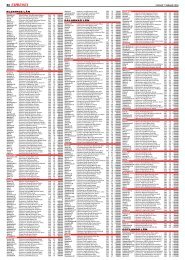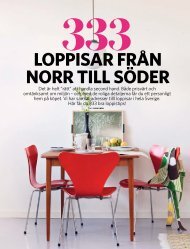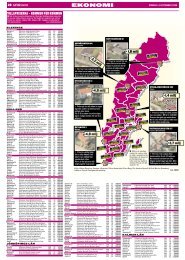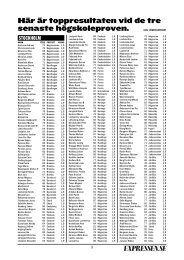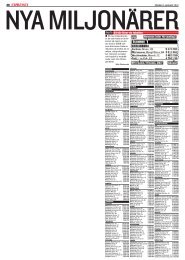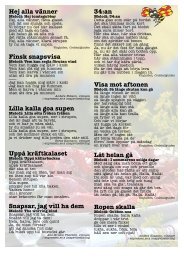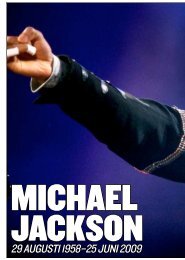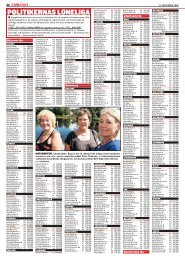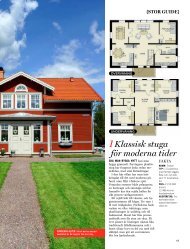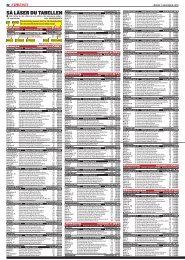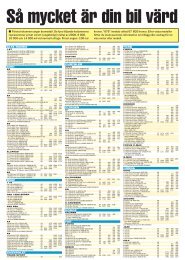stockholm boxes-second report--final -to send via e-mail - Expressen
stockholm boxes-second report--final -to send via e-mail - Expressen
stockholm boxes-second report--final -to send via e-mail - Expressen
You also want an ePaper? Increase the reach of your titles
YUMPU automatically turns print PDFs into web optimized ePapers that Google loves.
The S<strong>to</strong>ckholm exhibition was prepared by Pontus Hultén, Direc<strong>to</strong>r of theModerna Museet, and Kasper König, an independent cura<strong>to</strong>r (now direc<strong>to</strong>r of theMuseum Ludwig, Cologne), who worked directly with Warhol in New York. In Sweden,Hultén worked with the art critic Olle Granath (later Direc<strong>to</strong>r of the Moderna Museet,1980-1989; now Permanent Secretary of the Royal Swedish Academy of Fine Arts), thegraphic designer John Melin (who designed numerous publications for the ModernaMuseet during Hultén’s tenure as Direc<strong>to</strong>r; now deceased), and the film cura<strong>to</strong>r Anna-Lena Wibom (Hultén’s wife and later Direc<strong>to</strong>r of the Swedish Film Institute). TheS<strong>to</strong>ckholm exhibition was undertaken with limited financial resources and organized in arelatively concentrated period of time between the summer of 1967 and early 1968. InJanuary 1968, König arranged for the transport of most of the exhibition’s contents byboat <strong>to</strong> Sweden—the 500 cardboard Brillo Soap Pads car<strong>to</strong>ns, Cow Wallpaper, andplastic Clouds were shipped as “display goods” with the “art works”: two print portfoliosand four rolls of unstretched Ten-Foot Flowers and Big Electric Chair canvases.A spirit of resourcefulness, improvisation, and collaboration informed thepreparations for the exhibition and its presentation. For example, when Warhol’s films,which were <strong>to</strong> be shown alongside his paintings in the museum’s galleries during theexhibition, failed <strong>to</strong> arrive from Warhol’s studio, Hultén and Wibom arranged <strong>to</strong> havefootage from circus films screened in their place. Rather than helium, the Clouds wereinflated with air, so that they rested on the ground rather than floating. Likewise, thestacks of 500 Brillo car<strong>to</strong>ns were re-arranged after weekly concerts in the galleries. Thiswas entirely in keeping with the experimental character of Hultén’s cura<strong>to</strong>rial style, inwhich the work of art was typically incorporated in<strong>to</strong> a broader interdisciplinary or2
documentary project. According <strong>to</strong> Olle Granath, when Warhol attended the opening inS<strong>to</strong>ckholm, he was pleased with the exhibition. 2After S<strong>to</strong>ckholm, the exhibition traveled <strong>to</strong> Amsterdam; Bern and Kassel; Oslo;and Berlin. Installation pho<strong>to</strong>graphs from S<strong>to</strong>ckholm and the other museums participatingin the exhibition <strong>to</strong>ur, as well as museum receipts and shipping invoices, provide noindication that Brillo Soap Pads <strong>boxes</strong> made of wood or any material other thancardboard were included among the cardboard <strong>boxes</strong>. The visual and documentaryevidence supports the first-hand recollections of Olle Granath. He has affirmed that onlycardboard Brillo Soap Pads <strong>boxes</strong> were exhibited in S<strong>to</strong>ckholm in 1968. 3The painted and printed plywood Brillo box sculptures that Warhol made in 1964for his exhibition at the Stable Gallery in New York were based on a design by thepainter James Harvey. The cardboard car<strong>to</strong>ns that the Brillo fac<strong>to</strong>ry supplied <strong>to</strong> the2 Kasper König’s letters <strong>to</strong> Pontus Hultén documenting the progress of Warhol’sexhibition for the Moderna Museet are on file in Hultén’s archives at the ModernaMuseet (hereafter cited as Hultén Archives). Olle Granath has published an account ofthe S<strong>to</strong>ckholm exhibition, “With Andy Warhol 1968,” in Andy Warhol: A Guide <strong>to</strong> 706Items in 2Hours 56 Minutes, ed. Eva Meyer-Hermann (Rotterdam: NAi Publishers,2007): pp. 00:10:00-00.13.00. Catalogue published on the occasion of the exhibition“Other Voices, Other Rooms,” Stedelijk Museum, Amsterdam (Oc<strong>to</strong>ber 12, 2007-January 13, 2008), Moderna Museet, S<strong>to</strong>ckholm (February 9-May 4, 2008).3 See Granath, Other Voices, Other Rooms, p. 00:12:00. On three occasions—in atelephone conversation with Sally King-Nero on May 15, 2002; in a telephoneconversation with Neil Printz on November 30, 2007; and in conversation with NeilPrintz in S<strong>to</strong>ckholm on December 17, 2008—Granath also affirmed that only cardboard<strong>boxes</strong> and no “hard” <strong>boxes</strong> were exhibited in S<strong>to</strong>ckholm in 1968. Granath confirmed thisaccount <strong>to</strong> the newspaper <strong>Expressen</strong> (May 30, 2007): “We never had any Brillo <strong>boxes</strong>built <strong>to</strong> be exhibited in 1968. We purchased 500 Brillo <strong>boxes</strong> in corrugated car<strong>to</strong>n fromthe [Brillo] fac<strong>to</strong>ry in New York, and those were the ones we showed.” In response <strong>to</strong> aquery from the Estate of Andy Warhol, on December 19, 1993, Kasper König wrote: “AllBrillo <strong>boxes</strong> came directly as cardboard [König’s emphasis] <strong>boxes</strong> from the Brillocompany in Brooklyn-They were the real stuff—only for display!” (See section 3.) Inconversation with Neil Printz on November 11, 2007, however, König noted that henever saw the exhibition in S<strong>to</strong>ckholm.3
S<strong>to</strong>ckholm exhibition differed from the Stable Gallery <strong>boxes</strong> in one principal detail. Atthe corner of each of the four sides on the cardboard containers is a blue insert with thenotations “1A400; 24/18; Pad Giant.” The substitution of real Brillo Soap Pads car<strong>to</strong>nsfor the box sculptures made by Warhol in 1964 reflects both the limited resources andimprovisa<strong>to</strong>ry spirit of the S<strong>to</strong>ckholm exhibition. It would have been prohibitivelyexpensive for the Moderna Museet <strong>to</strong> ship a large quantity of Warhol’s box sculpturesfrom New York or <strong>to</strong> fabricate copies for the exhibition in Sweden. Moreover, according<strong>to</strong> Olle Granath, the idea for the S<strong>to</strong>ckholm exhibition had been <strong>to</strong> exhibit 300 <strong>to</strong> 500<strong>boxes</strong>, many more than the approximately 100 sculptures Warhol produced in 1964. Theserial profusion and presentation of the 500 <strong>boxes</strong> in S<strong>to</strong>ckholm visibly reinforced theway Warhol had massed his sculptures at the Stable Gallery in New York so that theyfilled an entire room (figs. 1 and 2).Further, the substitution of real Brillo Soap Pads car<strong>to</strong>ns for his own boxsculptures was not without precedent in Warhol’s practice. An installation pho<strong>to</strong>graphfrom the 1966 Bos<strong>to</strong>n exhibition shows a group of ten Brillo Soap Pads <strong>boxes</strong> mountedon a shelf above a doorway. The <strong>boxes</strong> reveal the same “Pad Giant” insert as theS<strong>to</strong>ckholm <strong>boxes</strong> and were probably cardboard car<strong>to</strong>ns (fig. 3). Indeed, Warhol’s “worryabout keeping the Brillo <strong>boxes</strong> ‘clean’—rather than having them come out of the showvirtually ruined, as the <strong>boxes</strong> so often do” is the subject of a letter from the direc<strong>to</strong>r of theBos<strong>to</strong>n ICA <strong>to</strong> Warhol, written on September 14, 1966. This surely accounts for theunusual installation of the <strong>boxes</strong> on a ledge over a doorway rather than on the floor, andsuggests why Warhol might have substituted cardboard car<strong>to</strong>ns for his box sculptures.The previous year, when Warhol planned <strong>to</strong> include a group of eighty box sculptures in a4
1965 exhibition at the Jerrold Morris Gallery in Toron<strong>to</strong>, Canadian cus<strong>to</strong>ms haddetermined that they did not qualify for a duty-free exemption as sculptures, and theworks were withdrawn from the exhibition. This may also have influenced Warhol’sdecision <strong>to</strong> use real Brillo Soap Pads car<strong>to</strong>ns in his subsequent exhibitions in Bos<strong>to</strong>n,S<strong>to</strong>ckholm, and in a 1969 group exhibition, “New York 13”, at Vancouver Art Gallery(fig. 4). The substitution of real car<strong>to</strong>ns for box sculptures is not cited in the entries ineither the Bos<strong>to</strong>n or Vancouver catalogues. The flattened box flaps visible in theVancouver installation pho<strong>to</strong>graph indicates that they are cardboard <strong>boxes</strong> like thoseexhibited in S<strong>to</strong>ckholm in 1968.In 1968, Pontus Hultén had a small number of Brillo Soap Pads box sculpturesmade in Sweden, based on the cardboard car<strong>to</strong>ns shown in S<strong>to</strong>ckholm rather than on the1964 sculptures by Warhol. Olle Granath recalls seeing a stack of about ten “hard” <strong>boxes</strong>in Hultén’s office at the Moderna Museet some time between the spring and August of1968. According <strong>to</strong> Granath, he unders<strong>to</strong>od that Hultén had a “special agreement” withWarhol that authorized him <strong>to</strong> produce “some of these <strong>boxes</strong>.” 4 It is not known whetherthe <strong>boxes</strong> were made at the Moderna Museet or elsewhere in Sweden. In a 1969 ledger at4 Granath, May 15, 2002, December 3, 2007, and December 17, 2008. In a December 4,1998 letter <strong>to</strong> Arch Gillies, then President of the Andy Warhol Foundation for the VisualArts, Granath wrote: “I got my <strong>boxes</strong> from Pontus Hultén in the spring of 1968 afterhaving helped him do Andy Warhol’s show at the Moderna Museet in S<strong>to</strong>ckholm.” Inlater conversations on December 3, 2007 and December 17, 2008, Granath recalledseeing the <strong>boxes</strong> in late August. In <strong>Expressen</strong>, May 30, 2007, Granath stated: “Hulténdid, with Andy Warhol’s blessing, have a number of <strong>boxes</strong> made. No more than 15. Butthese were never part of the exhibition. They were made later, after the close of theexhibit.” On August 11, 2007, Granath wrote <strong>to</strong> Claudia Defendi in response <strong>to</strong> herquestions: “I do regret that I cannot give you the exact number [of S<strong>to</strong>ckholm type <strong>boxes</strong>]since I had nothing <strong>to</strong> do with the production of these <strong>boxes</strong>. But when Pontus Hulténgave me three <strong>boxes</strong>, in the early autumn of 1968… they were all piled up in his office. Itcould have been ten, it could have been twelve but not more.”5
the Moderna Museet, an entry for “Brillo Boxes (Screen Print),” dated August 28,suggests that they were executed under the auspices of the museum, if not on itspremises. It is likely that this ledger entry records the date when the invoice for the Brilloscreen print had been paid by the Moderna Museet, but that the <strong>boxes</strong> were producedsomewhat earlier, probably during the spring or summer of 1968, as Olle Granath hasstated on several occasions.The precise number of Brillo <strong>boxes</strong> produced by Hultén in 1968 is not recorded,but the recollections of Granath and Ulf Linde (a cura<strong>to</strong>r at the Moderna Museet) indicatethat approximately ten <strong>to</strong> fifteen wood <strong>boxes</strong> were made at this time. 5To date, theAuthentication Board has been able <strong>to</strong> document six such <strong>boxes</strong>. These six <strong>boxes</strong>,produced by Hultén in 1968 (hereafter referred <strong>to</strong> as S<strong>to</strong>ckholm type <strong>boxes</strong>) may bedistinguished from the Brillo <strong>boxes</strong> made by Warhol for his exhibition at the StableGallery, New York in 1964 (hereafter referred <strong>to</strong> as Stable Gallery <strong>boxes</strong>) by thefollowing characteristics: (1) design; (2) dimensions; (3) materials and construction; and(4) surface preparation and finish.The design of the Stable Gallery <strong>boxes</strong> is based on an earlier Brillo Soap Pads boxcar<strong>to</strong>n pro<strong>to</strong>type and does not include the “Pad Giant” insert; the S<strong>to</strong>ckholm type <strong>boxes</strong>are based on the Brillo Soap Pads car<strong>to</strong>ns exhibited in S<strong>to</strong>ckholm in 1968 and include the“Pad Giant” insert in an upper corner of each of its four side-faces. The <strong>to</strong>ps of theStable Gallery <strong>boxes</strong> are printed with a smaller and modified version of the design thatappears on each of the four side-faces; only the bot<strong>to</strong>m surface has no design. TheS<strong>to</strong>ckholm type <strong>boxes</strong> have no designs on the <strong>to</strong>p and bot<strong>to</strong>m surfaces.5 See fn. 2 and fn. 3. In <strong>Expressen</strong>, (May 30, 2007), Linde stated “I did see some tenwooden Brillo <strong>boxes</strong> in connection with the exhibition. There were no more than that.”6
The Stable Gallery <strong>boxes</strong> were constructed by a cabinet maker in New York,based on Warhol’s specifications. They measure 17 x 17 x 14 inches (which converts <strong>to</strong>approximately 43.2 x 43.2 x 35.6 cm). The S<strong>to</strong>ckholm type <strong>boxes</strong>, constructed in Europe,measure 44 x 44 x 36 cm (which converts <strong>to</strong> approximately 17 3/8 x 17 3/8 x 14 ¼inches). 6This slight variation in size probably derives from the fact that the S<strong>to</strong>ckholmtype <strong>boxes</strong> were made in Europe from one of the cardboard car<strong>to</strong>ns exhibited at theModerna Museet.The Stable Gallery <strong>boxes</strong> are constructed of plywood; the S<strong>to</strong>ckholm type <strong>boxes</strong>are constructed of particle board. 7The six sides of each Stable Gallery box are abutted;the six sides of each S<strong>to</strong>ckholm type box are mitered at the edges. All six sides of bothStable Gallery and S<strong>to</strong>ckholm type <strong>boxes</strong> are hand-painted white, but the painted surfacesof the S<strong>to</strong>ckholm <strong>boxes</strong> are smoother and more opaque. It seems likely that theS<strong>to</strong>ckholm <strong>boxes</strong> were painted and sanded multiple times <strong>to</strong> achieve a high degree offinish before they were printed.In 1970, Warhol authorized the Pasadena Art Museum <strong>to</strong> produce a set of 100Brillo Soap Pads <strong>boxes</strong> (at its own expense) for the retrospective of his work at the6 The centimeter dimensions of the S<strong>to</strong>ckholm type <strong>boxes</strong> are the average of two such<strong>boxes</strong> measured by the Moderna Museet’s Chief Conserva<strong>to</strong>r, Lars Byström. Thesedimensions were included in a November 2007 <strong>report</strong> written by the museum’s Direc<strong>to</strong>r,Lars Nittve, with Byström, that compared examples of Brillo <strong>boxes</strong> produced by Hulténin 1968 and in 1990, including the six Brillo <strong>boxes</strong> owned by the Moderna Museet (seebelow). The dimensions of each box, however, are quite close in size, and are as follows:(1) 44 x 44.2 x 36.4 cm; and (2) 43.9 x 43.9 x 36.1 cm.7 In the Andy Warhol Catalogue Raisonné, the support medium of these works is cited asMasonite. See Georg Frei and Neil Printz, Edi<strong>to</strong>rs, Sally King Nero, Executive Edi<strong>to</strong>r,Andy Warhol Catalogue Raisonné. Volume 2A: Paintings and Sculptures 1964-1969(New York and London: Phaidon Press, 2004), cat. nos. 721.1-721.94. Particle board is amore general term, which refers <strong>to</strong> any compressed board made of wood fibers, includingthe brand name Masonite.7
museum. He then donated these <strong>boxes</strong> <strong>to</strong> the museum. A signed letter documentsWarhol’s authorization, and specifies two conditions: first, that the <strong>boxes</strong> <strong>to</strong>ur with theexhibition of his work beginning at the Pasadena Art Museum; and <strong>second</strong>, that “all onehundred <strong>boxes</strong> will remain in the permanent collection of the Pasadena Art Museum afterthe show.” The <strong>boxes</strong> were produced in California, <strong>to</strong> the specifications of 20 x 20 x 17inches, visibly larger than the Stable Gallery <strong>boxes</strong>. 8 The Andy Warhol CatalogueRaisonné has identified as many as sixteen additional Brillo <strong>boxes</strong>, identifiable asPasadena type <strong>boxes</strong>, beyond the set of 100 <strong>boxes</strong> belonging <strong>to</strong> the Pasadena ArtMuseum, that were given as gifts or sold. 9 Contemporaneous with the Pasadena type<strong>boxes</strong>, Warhol authorized the Los Angeles County Museum <strong>to</strong> produce a set of 100Kellogg’s Corn Flakes <strong>boxes</strong> at its own expense that he donated <strong>to</strong> the museum. Like thePasadena type Brillo <strong>boxes</strong>, the Los Angeles type Kellogg’s <strong>boxes</strong> were made visiblylarger than the Kellogg’s <strong>boxes</strong> that Warhol produced in 1964. 10The Authentication Board has not found any comparable documentation <strong>to</strong>indicate that the <strong>boxes</strong> produced in 1968 were made with Warhol’s approval or hisknowledge. In a November 2007 <strong>report</strong>, the Moderna Museet has stated that “These<strong>boxes</strong> [the S<strong>to</strong>ckholm type <strong>boxes</strong>] are, according <strong>to</strong> records and catalogue texts,8 The letter is addressed <strong>to</strong> John Coplans, signed by Warhol, and dated April 10, 1969.The specifications appear in a letter and an invoice from the printer.9 See Andy Warhol Catalogue Raisonné. Volume 2A: Paintings and Sculptures 1964-1969 (2004), cat. nos. 723-738.10 A letter from the Direc<strong>to</strong>r of LACMA <strong>to</strong> Warhol documents his gift. The Stable GalleryKellogg’s <strong>boxes</strong> measure 25 x 21 x 17 inches; the Los Angeles type Kellogg’s <strong>boxes</strong>measure 27 x 24 x 19 inches.8
constructed with permission of the artist.” 11 However, the Authentication Board has foundno record of Warhol’s permission either in Hultén’s papers or in the archives of theModerna Museet <strong>to</strong> substantiate this statement. 12As previously noted, Olle Granath has stated that when he first saw the S<strong>to</strong>ckholmtype <strong>boxes</strong> in the spring or summer of 1968, he unders<strong>to</strong>od that Hultén had a “specialagreement” with Warhol that authorized him <strong>to</strong> make these <strong>boxes</strong>. 13 Given the personalfriendship that existed between them, the improvisational character of the S<strong>to</strong>ckholmexhibition, and the earlier date of the S<strong>to</strong>ckholm type <strong>boxes</strong> relative <strong>to</strong> the Pasadena typeand Los Angeles type <strong>boxes</strong>, it is possible that some sort of informal, verbal agreementmay have taken place between Hultén and Warhol in early 1968. The AuthenticationBoard has been unable either <strong>to</strong> establish or invalidate this possibility.Finally, Hultén’s intentions with regard <strong>to</strong> the 1968 S<strong>to</strong>ckholm type <strong>boxes</strong> are notclear, since they were produced after Warhol’s exhibition at the Moderna Museet andonly a limited number of examples were made. Of the six S<strong>to</strong>ckholm type <strong>boxes</strong> known<strong>to</strong> exist, three were given <strong>to</strong> Granath as “souvenirs” for having helped Hultén with the11 See fn 6: <strong>report</strong> by Moderna Museet Direc<strong>to</strong>r, Lars Nittve, and Chief Conserva<strong>to</strong>r, LarsByström. The statement cited above is also quoted in Eileen Kinsella, “The Brillo-BoxScandal,” Art News (November 2009): 94-99, p. 98.12 The Board has also conducted a search of the archive of Warhol’s papers at the AndyWarhol Museum, Pittsburgh, in reference <strong>to</strong> documents relating <strong>to</strong> Pontus Hultén, theModerna Museet, S<strong>to</strong>ckholm, and the Brillo box sculptures. However the WarholArchive in Pittsburgh is massive, and only about half of the material in its archives hasbeen catalogued <strong>to</strong> date. Nonetheless, no documentation has been found thus far thatwould either substantiate or invalidate the claim that Warhol granted Hultén permission<strong>to</strong> produce Brillo box sculptures in 1968.13 Granath <strong>to</strong> Sally King-Nero, May 15, 2002. On November 30, 2007, he stated that heunders<strong>to</strong>od from Hultén that “Warhol had authorized some of these <strong>boxes</strong>.”9
Moderna Museet exhibition. 14 Hultén kept the other three for his own use; two served asbedside tables for his children. 15(2) Malmö type <strong>boxes</strong>, 1990In 1985, Hultén, the conceptual artists Daniel Buren and Sarkis, and the poet andart his<strong>to</strong>rian Serge Fauchereau founded the Institut des Hautes Etudes en Arts Plastiques(IHEAP), an advanced studio program in Paris, that was based on such models as theBauhaus and Black Mountain College. In late 1989, under the auspices of IHEAP, Hulténbegan <strong>to</strong> work on an omnibus exhibition of twentieth-century art for the Russian Museumin Leningrad, that he called “Le Terri<strong>to</strong>ire de l’Art.” For the exhibition in 1990, Hulténarranged <strong>to</strong> have a set of Brillo <strong>boxes</strong> produced in Malmö, Sweden (hereafter referred <strong>to</strong>as the Malmö type <strong>boxes</strong>.) With the 1968 S<strong>to</strong>ckholm type <strong>boxes</strong>, the 1990 Malmö type<strong>boxes</strong> constitute the <strong>second</strong> and larger body of Brillo box sculptures that were producedunder Pontus Hultén’s direction.In early 1990, carpenters at the Malmö Konsthall constructed the <strong>boxes</strong> andpainted them white, using one of the cardboard car<strong>to</strong>ns exhibited in S<strong>to</strong>ckholm in 1968 asa pro<strong>to</strong>type. 16 They were printed by Bengt Andersson, a silkscreen printer who had14 Granath, December 3, 2007. See also fn. 4: Granath’s December 4, 1998 letter <strong>to</strong> ArchGillies.15 Anna-Lena Wibom in conversation with Neil Printz, S<strong>to</strong>ckholm, December 16, 2008.Of the three that Hultén kept, one was later given <strong>to</strong> the printer who silkscreened theMalmö type <strong>boxes</strong>. (See section 3.)16 See <strong>Expressen</strong>, May 30, 2007. Björn Springfeldt, Direc<strong>to</strong>r of the Moderna Museet(1989-96), confirmed this account <strong>to</strong> Neil Printz in an e<strong>mail</strong> on April 27, 2008, and atelephone conversation on May 11, 2009. Springfeldt began working at the ModernaMuseet as an Associate Cura<strong>to</strong>r in July 1968, and “continued <strong>to</strong> collaborate [with Hultén]until the end of Pontus’ life,” as he wrote in his e<strong>mail</strong>. From 1985 <strong>to</strong> 1989, he was theDirec<strong>to</strong>r of the Malmö Municipal Art Gallery. On Hultén’s behalf, he contacted its chief10
worked with the graphic designer John Melin and his partner Anders Osterlin. Melinintroduced Hultén <strong>to</strong> Andersson, who provided him with one of the 1968 S<strong>to</strong>ckholm type<strong>boxes</strong> <strong>to</strong> use as a basis for his screens. An invoice from the printer, dated May 7, 1990, <strong>to</strong>Hultén at IHEAP documents both the date of production and the number of <strong>boxes</strong>printed: 105 in all. From Malmö, the <strong>boxes</strong> were shipped <strong>to</strong> S<strong>to</strong>ckholm, where they weres<strong>to</strong>red at the Moderna Museet. 17The design of the 1990 Malmö type <strong>boxes</strong> duplicates the 1968 S<strong>to</strong>ckholm type<strong>boxes</strong>, including the “Pad Giant” insert that appears on the cardboard car<strong>to</strong>ns exhibited inS<strong>to</strong>ckholm in early 1968. Likewise, the <strong>to</strong>p surface of the Malmö type <strong>boxes</strong> is paintedbut left blank, like the S<strong>to</strong>ckholm type <strong>boxes</strong>. As with the S<strong>to</strong>ckholm type <strong>boxes</strong>, theMalmö type <strong>boxes</strong> are made of particle board rather than plywood. The Malmö type<strong>boxes</strong> can be distinguished from the S<strong>to</strong>ckholm type <strong>boxes</strong>, as follows: (1) sides of theMalmö type <strong>boxes</strong> are abutted at the edges; the sides of the S<strong>to</strong>ckholm type <strong>boxes</strong> aremitered; (2) the sides of the Malmö type <strong>boxes</strong> are joined by nails that appear <strong>to</strong> havebeen inserted with a nail gun; the S<strong>to</strong>ckholm type <strong>boxes</strong> were nailed by hand; and (3) thewhite paint on the surface of the Malmö type <strong>boxes</strong> appears <strong>to</strong> have been applied with atechnician, Arne Göransson, <strong>to</strong> have the <strong>boxes</strong> constructed. Springfeldt then contacted thedesigner John Melin <strong>to</strong> arrange for the silkscreening.17 This account was provided by the printer of the Malmö type <strong>boxes</strong> Bengt Andersson ina telephone conversation with Neil Printz and Sally King-Nero on November 11, 2007,and in conversation with Neil Printz on Oc<strong>to</strong>ber 28, 2009. It is supported by documentsin the Hultén Archives and provided by Andersson <strong>to</strong> the Board. Bo Nilsson, ChiefCura<strong>to</strong>r of the Moderna Museet (1990-91), recalled seeing the <strong>boxes</strong> in production inMalmö in 1990, and remembered them both before and after they had been printed (in atelephone conversation with Neil Printz on May 5, 2009.)11
oller; the surfaces of the S<strong>to</strong>ckholm type <strong>boxes</strong> have been painted by hand and arehighly finished, probably as a result of sanding and multiple coats of paint. 18In contrast <strong>to</strong> the S<strong>to</strong>ckholm type <strong>boxes</strong>, Hultén’s purposes in producing theMalmö type <strong>boxes</strong> remain clear. To the individuals involved in their production or awareof their production, the Malmö type <strong>boxes</strong> made expressly for “Le Terri<strong>to</strong>ire de l’Art”were exhibition “scenography.” 19 Moreover, they believed that there had been an “oldauthorization” from Warhol <strong>to</strong> Hultén permitting him <strong>to</strong> produce copies of the Brillo<strong>boxes</strong>. Bengt Andersson, the printer of the Malmö type <strong>boxes</strong>, observed that both JohnMelin and Hultén led him <strong>to</strong> believe that the 1990 <strong>boxes</strong> were an “effort <strong>to</strong> complete theseries” initiated in 1968. 20The production of authorized copies, designated as “replicas,” of an artist’s workis not surprising in the context of Hultén’s cura<strong>to</strong>rial his<strong>to</strong>ry. In 1961, Ulf Linde made thefirst replica of Marcel Duchamp’s Large Glass (1915-23) for Hultén’s exhibition “Art inMotion” at the Moderna Museet. Duchamp inscribed the 1961 replica as a “copieconforme,” and donated it <strong>to</strong> the Moderna Museet in 1963. During 1991 and 1992, Lindemade another replica of the Large Glass for Hultén’s 1993 Duchamp exhibition at the18 These distinctions are based on side-by-side examinations of a 1964 Stable Gallery box,1968 S<strong>to</strong>ckholm type box, and a 1990 Malmö type box, conducted by the AuthenticationBoard on November 27, 2007. A prior <strong>report</strong> by Lars Nittve, Direc<strong>to</strong>r, and Lars Byström,Chief Conserva<strong>to</strong>r, Moderna Museet, dated November 2007, comparing two S<strong>to</strong>ckholmtype <strong>boxes</strong> with the six Malmö type <strong>boxes</strong> owned by the Moderna Museet and a seventhMalmö type box, noted essentially the same distinctions between the surface preparationsof each type of box sculpture.19 In conversations with Neil Printz, Björn Springfeldt and Bo Nilsson each usedessentially the same terms—i.e., “exhibition scenography” (Springfeldt, May 11, 2009)and “scenography for the show” (Nilsson, May 5, 2009)—in their respective accounts ofthe Malmö type <strong>boxes</strong>.20 Bengt Andersson, November 20, 2007 and January 29, 2010. Björn Springfeldt usedthe expression “old authorization” (May 11, 2009).12
Palazzo Grassi, Venice. This posthumous replica was produced with the authorization ofDuchamp’s widow, Alexina (Teeny) Duchamp. In a 1996 interview with Hans UlrichObrist, Hultén recalled a Duchamp exhibition that he had organized in a books<strong>to</strong>re in1960: “At the books<strong>to</strong>re, we did a small show—we didn’t even have a Box-in-a-Valise(1941-1968), but managed <strong>to</strong> come up with replicas. Duchamp later signed everything.He loved the idea that an artwork could be repeated. He hated ‘original’ artworks withprices <strong>to</strong> match.” 21During the summer of 1968, after Warhol’s exhibition, when the S<strong>to</strong>ckholm type<strong>boxes</strong> were made, carpenters at the Moderna Museet reconstructed Vladimir Tatlin’s lostModel of a Monument <strong>to</strong> the Third International (1919-20) for a Tatlin exhibition at theModerna Museet. In fact, the exhibition consisted entirely of reconstructions of Tatlin’swork, due <strong>to</strong> the fact that loans were unavailable from Russian museums. The emphasison documentation and reconstructions led Hultén <strong>to</strong> describe the project as “conceptual.”As he later commented <strong>to</strong> Obrist: “We reconstructed Tatlin’s Tower in 1968, using themuseum’s own carpenters, not specialists brought in from the outside. This approach <strong>to</strong>installing exhibitions began <strong>to</strong> create a phenomenal collective spirit—we could put up anew show in five days.” 2221 Interview with Pontus Hultén, 1996 (first published in Artforum, April 1997) in HansUlrich Obrist, A Brief His<strong>to</strong>ry of Curating (Zurich: Ringier Kunstverlag AG, 2008), p.34.22 Ibid., pp. 33-44. See also Nathalie Leleu, “The Model of Vladimir Tatlin’s Monument<strong>to</strong> the Third International: Reconstruction as an Instrument of Research and States ofKnowledge.” Tate Papers, Autumn 2007. For Leleu’s text and other related papers on thesubject of the replica in modern sculpture, see “Inherent Vice: The Replica and itsImplications” in Modern Sculpture Workshop, held at Tate Modern on Oc<strong>to</strong>ber 18–19,2007, and supported by The Andrew W. Mellon Foundation:http://www.tate.org.uk/research/tateresearch/tatepapers/07autumn/13
ecalled:Björn Springfeldt, Direc<strong>to</strong>r of the Moderna Museet from 1989 <strong>to</strong> 1996, hasPontus came from a time when art was [the] bearer of ideas, not of economicalvalues, and he had reconstructions made of works by Duchamp—all lateracknowledged by Duchamp and signed as copies conforme—as well [as] ofworks by Tatlin, and when Pontus asked me <strong>to</strong> do a show for blind people I hadcopies made of sculptures (<strong>to</strong> be exhibited in a black room) by Brancusi andGiacometti (with inscription on the copies that they were copies and should bedestroyed after the show), which also happened…Springfeldt added that he unders<strong>to</strong>od “that the reproductions should be destroyed afterTerri<strong>to</strong>rium Artis—after having made their point as idea.” 23When “Le Terri<strong>to</strong>ire de l’Art” was on view in Leningrad (May 31-July 16, 1990),it seems likely that as few as ten Malmö type <strong>boxes</strong> were included. This number is basedon several of the exhibition lists prepared by Hultén’s secretary at IHEAP, 24 and on therecollections of Olle Granath, who visited the exhibition. At the time, Granath noticedthe differences in facture between the <strong>boxes</strong> he owned and the <strong>boxes</strong> exhibited inLeningrad. He described the latter as “poorly executed,” and observed that this distressedhim because he thought that Warhol had always cared about the way his work looked. 25The catalogue for the Leningrad exhibition is modest. The <strong>boxes</strong> that wereexhibited are not identified or individually catalogued. In their place is an installationview of the 1968 S<strong>to</strong>ckholm exhibition, showing the cardboard <strong>boxes</strong> massed in anirregular stack. The image is accompanied by a brief biography of Warhol and thefollowing legend, written by Hultén:23 E<strong>mail</strong> <strong>to</strong> Neil Printz, on April 27, 2009.24 See Hultén Archives, Moderna Museet.25 Granath in conversation with Neil Printz, on December 17, 2008.14
L’idée du “ready-made” (voir la Roue de bicyclette, 1913, de Marcel Duchamp)est ici poussé encore plus loin. L’artiste a choisi l’objet le plus résolument banalet, en l’accumulant, a produit un effet d’abandon hallucinant qui a sur<strong>to</strong>ut commeobjet une <strong>to</strong>tale absence de sens qui peut ressembler, par exemple, au chantgrégorien.[The idea of the “ready-made” (see the Bicycle Wheel, 1913, by MarcelDuchamp) is pushed still farther here. The artist has chosen the most resolutelybanal object, and in accumulating it, has produced an effect of hallucina<strong>to</strong>ryabandon that above all has as its object a complete absence of meaning, whichmight be said, for example, <strong>to</strong> resemble a Gregorian chant.] 26Hultén’s entry indicates the degree <strong>to</strong> which he viewed Warhol’s work through theperspective of Duchamp’s example. Following the logic of Duchamp and taking it <strong>to</strong>another power, Hultén interpreted Warhol’s 1964 Stable Gallery box sculptures not asfactured works of art but as repeatable ready-made objects, that were interchangeablewith real Brillo Soap Pads car<strong>to</strong>ns or replicas.Shortly after “Le Terri<strong>to</strong>ire de l’Art”, Hultén lent forty-five of the 105 Malmötype <strong>boxes</strong> <strong>to</strong> a retrospective of Warhol’s work organized by Steingrim Laursen for theLouisiana Museum in Humlebaek, Denmark (September 22, 1990-January 6, 1991). Thiswas the <strong>second</strong> of three Warhol exhibitions organized by Laursen for the LouisianaMuseum. The forty-five <strong>boxes</strong> were stacked on a broad platform in the middle of one ofthe museum’s galleries, under an accumulation of Silver Clouds (fig. 5). On the loanform for the works, the word “répliques” has been added in parentheses by an unknownhand. 27 The catalogue, however, does not identify them as such; the entry simply records26 Le Terri<strong>to</strong>ire de l’Art (Paris and Leningrad: Institut des Hautes Etudes en ArtsPlastiques and Musée Russe, 1990), p. 62. Translation by Neil Printz.27 See Hultén Archives, Moderna Museet; and exhibition records, Louisiana Museum,Humlebaek. According <strong>to</strong> Bo Nilsson, who assisted Laursen with loans from Swedishcollections, including the Malmö type <strong>boxes</strong>, Laursen was aware that these <strong>boxes</strong> were15
the works as “Boxes, 1964/Kasser [<strong>boxes</strong>]/ Private collection.” A reproduction elsewherein the catalogue shows a single 1964 Stable Gallery box, identified as “Brillo-kar<strong>to</strong>n1964” and cross-referenced <strong>to</strong> the catalogue entry. 28In 1992, Hultén organized an expanded version of the Russian exhibition as“Terri<strong>to</strong>rium Artis” for the new Kunst–und Austellungshalle der BundesrepublikDeutschland in Bonn. This exhibition, on view from June 19 <strong>to</strong> September 20, 1992, wasmore ambitious, better funded, and received powerful institutional and political support.For example, in one of several letters in Hultén’s archives from Vernon Walters, theAmerican Ambassador <strong>to</strong> the Federal Republic of Germany at this time, addressed <strong>to</strong> thedirec<strong>to</strong>rs of major American museums, he wrote: “I understand that Mr. Hultén informedyou of Chancellor Kohl’s personal interest in this project, and I would like <strong>to</strong> add thatPresident Bush also has expressed his interest in and support of this exhibit.” Installationpho<strong>to</strong>graphs indicate that probably all of the 105 Malmö type <strong>boxes</strong> were exhibited inBonn (fig. 6), although the catalogue reproduces only a 1964 Stable Gallery box, and theentry records the works as “Brillo Boxes 1964/silkscreen on wood/Each: 43,5 x43,5x35,6 cm/ Private collection”—much as they were recorded in the LouisianaMuseum catalogue. Hultén also includes a slightly modified version of the annotationfrom the Leningrad catalogue that relates Warhol’s Brillo <strong>boxes</strong> <strong>to</strong> “the idea ofreadymade (Duchamp)”. 29replicas produced in 1990. Copies of wall text and the checklist from the Louisianaexhibition have not been found. In conversation with Neil Printz, when asked if themuseum would have identified the Brillo <strong>boxes</strong> as replicas on the wall text and checklist,Nilsson replied that it was unlikely (May 5, 2009).28 Andy Warhol (Humlebaek: Louisiana Museum, 1990), pp. 6, 73.29 Pontus Hultén, Terri<strong>to</strong>rium Artis, (Bonn: Kunst–und Austellungshalle derBundesrepublik Deutschland and Verlag Gerd Hatje, 1992), pp. 358-59, cat. no. 184. The16
Thus, on three occasions between 1990 and 1992, Malmö type <strong>boxes</strong>, produced in1990, were publically exhibited: approximately ten in Leningrad in 1990; forty-five inDenmark from 1990 <strong>to</strong> 1991; and all 105 in Bonn in 1992. The production of the Malmötype <strong>boxes</strong> for the exhibitions in Leningrad and Bonn may have been a logical extensionof cura<strong>to</strong>rial practices embraced by Hultén. However, the Malmö type <strong>boxes</strong> were notacknowledged as having been produced in 1990, instead they were conflated with the1964 Stable Gallery <strong>boxes</strong>; nor was the Estate of Andy Warhol ever notified of theexistence of the Malmö type <strong>boxes</strong>. This violated the very pro<strong>to</strong>cols that Hultén and theModerna Museet had put in place with respect <strong>to</strong> the replicas of the work of Duchampand Tatlin. Moreover, the confusion of Warhol’s 1964 Stable Gallery box sculptures withready-made Brillo Soap Pads car<strong>to</strong>ns and the absence of transparent and rigorousguidelines relating <strong>to</strong> the production and exhibition of copies of Warhol’s work from1990 <strong>to</strong> 1992 created the conditions that allowed subsequent dis<strong>to</strong>rtions of fact <strong>to</strong> goundetected for many years, until after Hultén’s death in 2006.(3) Subsequent events, 1994-2007full statement reads: “The idea of readymade [Hultén’s emphasis] (Duchamp) is putfurther here. The artist has in a <strong>to</strong>tally resolute way chosen the most banal massfabricatedobject which he then accumulated with a hallucinating carelessness, obtaininga monumental effect of self-interrogation.” The same page also cites a 1977 interviewwith Warhol: “I did all the [Campbell’s soup] cans in a row on a canvas, and then I got abox, and then it looked funny because it didn’t look real. I have one of the <strong>boxes</strong> here[now in the collection of the Andy Warhol Museum, Pittsburgh]. I did the cans on thebox, but it came out looking funny. I had the <strong>boxes</strong> already made up. They were brownand looked just like <strong>boxes</strong>, so I thought it would be great just <strong>to</strong> do an ordinary box.” Themeasurements recorded in Bonn are closer <strong>to</strong> those of the 1964 Stable Gallery <strong>boxes</strong> thanthe Malmö type <strong>boxes</strong>, which Lars Byström of the Moderna Museet recorded inNovember 2007 as 44.4 x 44.2 x 36.2 cm.17
In December 1994, the Estate of Andy Warhol first became aware of the fact thatHultén had produced Brillo Soap Pads <strong>boxes</strong> when the Belgian art dealer Ronny Van deVelde submitted ten Brillo <strong>boxes</strong> acquired from Hultén <strong>to</strong> the Estate for authentication.At this time, Christie’s London offered a single S<strong>to</strong>ckholm type box for sale onDecember 1, 1994, lot 54, as an undated White Brillo Box “acquired directly from theartist by the present owner in the 1960’s.” 30In response <strong>to</strong> questions from the Estate about the ten <strong>boxes</strong> submitted for review,Hultén signed the following statement in mid-December:Hereby the undersigned, Pontus Hultén, declares that he has sold twenty “BrilloBoxes” from his own collection <strong>to</strong> Ronny Van de Velde, Antwerpen, Belgium[however, only ten were submitted <strong>to</strong> the Estate at this time]. These “BrilloBoxes” were produced in S<strong>to</strong>ckholm in 1968, according <strong>to</strong> Andy Warhol’sinstructions. These “Brillo Boxes” were included in the exhibition “AndyWarhol” at the Moderna Museet, S<strong>to</strong>ckholm, February-March 1968.At the same time, the Estate also contacted Kasper König, who informed them that “AllBrillo <strong>boxes</strong> came directly as cardboard [König’s emphasis] <strong>boxes</strong> from the BrilloCompany in Brooklyn—They were the real stuff—only for display!” König, however,did not attend the opening or see the exhibition in S<strong>to</strong>ckholm. On December 29, 1994,Hultén offered a more detailed statement:The Brillos [in 1968] were stacked in front of the entrance rather high (see pho<strong>to</strong>in <strong>second</strong> edition of book [the Moderna Museet catalogue published in May1969]). There were ca. 100 wooden brillo-<strong>boxes</strong> made in Sweden according <strong>to</strong>Andy’s instruction (“why don’t you make them there?”) As the hundred did notseem enough in the rather big space some cardboard Brillo-<strong>boxes</strong> were added inthe upper part of the stack and in back. These came from the Fac<strong>to</strong>ry. I still haveone such cardboard box here… As far as I remember the show did not travel.Andy gave the Brillo-<strong>boxes</strong> <strong>to</strong> me. They were s<strong>to</strong>red for many years at the30 All eleven <strong>boxes</strong> appear <strong>to</strong> be Malmö type <strong>boxes</strong>, although this has not beencorroborated by examinations conducted after 2007, when information about these <strong>boxes</strong>came <strong>to</strong> light and their distinguishing characteristics were first identified.18
museum. I recuperated them when I moved <strong>to</strong> Los Angeles. I don’t think themuseum <strong>to</strong>day owns any Brillo-<strong>boxes</strong> The two paintings that Andy gave <strong>to</strong> themuseum [a Ten-Foot Flowers and Big Electric Chair painting] are still in thecollection and some other paintings were given and bought later.Thus, in the two statements provided <strong>to</strong> the Estate in December 1994, Hultén assertedthat: (1) all of the Brillo Soap Pads <strong>boxes</strong> he had produced were made in 1968; (2) theywere made “according <strong>to</strong> Andy Warhol’s instructions”; and (3) they were included inWarhol’s exhibition at the Moderna Museet in 1968. Hultén consistently maintained thisversion of events until his death in 2006. Based on his statements, the Estateauthenticated the ten <strong>boxes</strong> submitted in late 1994. The Andy Warhol Art AuthenticationBoard was established in 1995. Between 1995 and 2007, when information pertaining <strong>to</strong>the 1990 Malmö type <strong>boxes</strong> first came <strong>to</strong> light (see below), the Board authenticated fiftysevenBrillo Soap Pads <strong>boxes</strong> produced by Hultén as 1968 S<strong>to</strong>ckholm type <strong>boxes</strong>.In 1995, Hultén donated six Malmö type <strong>boxes</strong> <strong>to</strong> the Moderna Museet. Theofficial minutes of the Museum record the gift. 31 In late 1995, all six were included in anexhibition at the Rooseum in Malmö. The <strong>boxes</strong> were assigned a 1964 date in thecatalogue. When a visi<strong>to</strong>r <strong>to</strong> the Rooseum inquired about these works, the response wascontradic<strong>to</strong>ry and confused. Initially, the Rooseum informed him that that the <strong>boxes</strong>were “replicas,” probably produced in 1990. Subsequently, both the Rooseum and theModerna Museet informed him that they had been made in 1968, after the exhibition atthe Moderna Museet. 32 In 1996, however, the Moderna Museet de-accessioned all six31 The Moderna Museet minutes, dated June 19, 1995, simply record the six <strong>boxes</strong> asfollows: “Gift <strong>to</strong> the museum’s collections from Pontus Hultén, Paris: AndyWarhol/Brillo Boxes/MOMSk 253.” The last is the accession number.32 On Oc<strong>to</strong>ber 23, 1995, the Direc<strong>to</strong>r of the Rooseum wrote: “We put 1964 in thecatalogue because we had received this information from the Moderna Museet’s staff … Ibelieve those which are at the Rooseum are replicas which Pontus Hultén received19
works, although no account of why this occurred is recorded in the museum’s officialminutes. 33 The Board has learned, however, that Hultén’s <strong>boxes</strong> had been identified aslater replicas. 34 Unfortunately, this information went unrecorded, and Hultén’s <strong>boxes</strong>,which remained in the museum’s s<strong>to</strong>rage, were re-incorporated in<strong>to</strong> the collection fiveyears later. In November 2001, the Moderna Museet re-accessioned Hultén’s six <strong>boxes</strong>and assigned them new accession numbers. 35In November 2005, Hultén donated his private collection consisting ofapproximately 700 works of art <strong>to</strong> the Moderna Museet. A special exhibition andcatalogue in 2004, The Pontus Hultén Collection…, marked the coming gift, as well asthe dedication of a Pontus Hultén Study Gallery at the museum. The cataloguepermission <strong>to</strong> make for an exhibition of the Moderna Museet’s collections at theHermitage in Leningrad in the beginning of the 1990s, but I am not certain.” OnNovember 29, a different Rooseum staff member wrote: “When the <strong>boxes</strong> came here, itwas apparent that they were not from 1964, and during an investigation it appeared thatthey dated <strong>to</strong> 1990. Shortly after we had received that information, it was nonethelessdemonstrated, which is the latest finding, that these <strong>boxes</strong> date <strong>to</strong> 1968, <strong>to</strong> which we a<strong>to</strong>nce changed the label in the museum.” and on January 12, 1996, a Moderna Museetcura<strong>to</strong>r wrote: “1. The <strong>boxes</strong> were made in conjunction with the Warhol exhibition at theModerna Museet, 1968. 2. They were manufactured after the exhibition’s closing.”33 The Moderna Museet minutes for November 11, 1996 read: “Deaccessioned from thecollection: Andy Warhol/Brillo Boxes/MOMSk 253.”34 David Elliott, Direc<strong>to</strong>r of the Moderna Museet (1996-2001), wrote in an April 15, 2009e<strong>mail</strong> <strong>to</strong> Neil Printz: “As far as I remember it the <strong>boxes</strong> had not been accessioned before Iarrived and my information from Olle Granath … was that they were replicas (ofreplicas) and therefore not authentic. I left them well enough alone as documentarymaterial and not in the art collection.”35 The new accession numbers are MOM/ 2001/226:1-6. Lars Nittve, Direc<strong>to</strong>r of theModerna Museet since 2001, who provided the accessioning and de-accessioning recordsfrom 1995 and 1996, noted in a May 6, 2009 e<strong>mail</strong> <strong>to</strong> Neil Printz: “There are no traces,even in the minutes, regarding the November 2001 re-accessioning.” David Elliott wroteon April 15, 2009: “… although I left S<strong>to</strong>ckholm in Oc<strong>to</strong>ber 2001 I can’t imagine I wouldsuddenly have decided <strong>to</strong> accession them as a parting shot…” It would thus seem likelythat Hultén’s six <strong>boxes</strong> were re-accessioned during an interregnum between thedirec<strong>to</strong>rships of Elliott and Nittve. In his August 11, 2007 <strong>to</strong> Claudia Defendi, Granathrefers <strong>to</strong> the six <strong>boxes</strong> in the collection of the Moderna Museet as “Malmö <strong>boxes</strong>.”20
eproduces one of the cardboard Brillo <strong>boxes</strong> exhibited in 1968 and one of the six Malmötype <strong>boxes</strong> that he had donated <strong>to</strong> the museum in 1995. In the catalogue, the cardboardbox is identified as an “original box” and dated 1964; the Malmö type box is dated 1968.The same note citing the “idea” of Duchamp’s ready-made that had appeared in theLeningrad catalogue in 1990, and in a slightly modified version in Bonn in 1992,accompanied the reproductions. Hultén’s recollections of Warhol’s exhibition ModernaMuseet in 1968, which appear in the catalogue, quote the statement of December 29,1994 that Hultén had provided <strong>to</strong> the Andy Warhol Estate verbatim. 36In 1998, when one of the edi<strong>to</strong>rs of the Catalogue Raisonné interviewed Hulténabout the S<strong>to</strong>ckholm exhibition, Hultén informed him that 100 wood <strong>boxes</strong> had beenmade in Malmö in 1968 “according <strong>to</strong> Warhol’s instructions.” Since the 100 <strong>boxes</strong> werenot enough <strong>to</strong> fill up the large space at the museum, according <strong>to</strong> this account fromHultén, 400 Brillo car<strong>to</strong>ns were sent from the fac<strong>to</strong>ry in New York. 37 A later review by36 The Pontus Hultén Collection… (S<strong>to</strong>ckholm: Moderna Museet, 2004), pp. 360-67.Hultén writes: “The idea of the ready-made (like Roue de Bicyclette, 1913, by MarcelDuchamp) is pursued even further here. The artist has selected the most definitively banalof objects, and by stacking it up, has produced an effect of breathtaking recklessnesswhose primary subject is a <strong>to</strong>tal absence of meaning, which might call a Gregorian chant<strong>to</strong> mind, for example.” (p. 367)37 Georg Frei, co-Edi<strong>to</strong>r of Volumes 1 and 2 of the Andy Warhol Catalogue Raisonné,interviewed Hultén in Paris on March 3, 1998. Hultén informed Frei that the <strong>boxes</strong> hadmade by Gösta Svensson in Malmö. In conversation with Neil Printz on April 14, 2009,Svensson—a printer who often worked with John Melin—stated that he had printed boththe cover for the 1968 Moderna Museet catalogue as well as the SAS Airplane Ticket,and worked on the 2005 catalogue of the Pontus Hultén collection for the ModernaMuseet, but that he had not printed any Brillo <strong>boxes</strong> for Hultén in 1968. On August 23,1996, Frei examined the Warhol works in the collection of the Moderna Museet for theCatalogue Raisonné. He examined only one of the six <strong>boxes</strong> that Hultén had donated in1995, having been informed by a staff member of the museum that all the others were thesame and should be seen as “replicas.” This was three months before the <strong>boxes</strong> were deaccessioned,and no reference was made <strong>to</strong> the fact that the <strong>boxes</strong> had been produced in1990.21
the Catalogue Raisonné edi<strong>to</strong>rs of the installation pho<strong>to</strong>graphs from S<strong>to</strong>ckholm and theexhibition <strong>to</strong>ur, however, indicated that Kasper König’s 1994 account, in which heasserted that only cardboard <strong>boxes</strong> provided by the Brillo fac<strong>to</strong>ry had been exhibited, wasprobably correct. In 2002, when the manuscript of Volume 2 of the Andy WarholCatalogue Raisonné was being prepared for publication, both Hultén and Olle Granathwere contacted by an edi<strong>to</strong>r of the Catalogue Raisonné. Hultén never directly responded<strong>to</strong> questions concerning whether or not the <strong>boxes</strong> produced in 1968 had been included inthe exhibition. Granath confirmed König’s account, and informed the CatalogueRaisonné that the <strong>boxes</strong> produced in 1968 were made after the exhibition. 38Based on König and Granath’s respective accounts, when Volume 2 of theCatalogue Raisonné was published in 2004, it noted that Warhol’s Brillo Soap Pads boxsculptures were represented in the S<strong>to</strong>ckholm exhibition and its <strong>to</strong>ur by cardboard“facsimiles” that “functioned both as an exhibition set and as a pro<strong>to</strong>type that was used <strong>to</strong>produce a set of approximately one hundred wood <strong>boxes</strong> fabricated in Sweden at thistime.” Although the Catalogue Raisonné differed from Hultén on one point, concerningwhether or not the Brillo <strong>boxes</strong> produced in 1968 had been included in the S<strong>to</strong>ckholmexhibition, no information or documentation had come <strong>to</strong> light as yet that would indicate38 Sally King-Nero, Executive Edi<strong>to</strong>r of Volume 2 of the Catalogue Raisonné, spoke bytelphone with Pontus Hultén on April 4, 2002 and with Olle Granath on May 15, 2002.Moreover, after two of the three <strong>boxes</strong> that Hultén had given him failed <strong>to</strong> sell atChristie’s, New York, on November 20, 1998, Granath wrote <strong>to</strong> Arch Gilles, thenPresident of the Andy Warhol Foundation for the Visual Arts, noting: “A couple of yearsago at least one box from the same series belonging <strong>to</strong> Pontus Hultén was sold with acertificate from your foundation. It was probably imprudent of me not <strong>to</strong> ask you for thesame authorization.”(December 4, 1998) In early 1999, Granath submitted these two<strong>boxes</strong> <strong>to</strong> the Andy Warhol Authentication Board. He subsequently sold the third box. Itsnew owner submitted the box <strong>to</strong> the Authentication Board in 2004. On none of theseoccasions, did Granath make any mention of the <strong>boxes</strong> that Hultén had produced in 1990.22
that most of the <strong>boxes</strong> produced by Hultén had, in fact, not been made in 1968, as hemaintained, but in 1990. Accordingly, ninety-four Brillo <strong>boxes</strong>, identified as “S<strong>to</strong>ckholmtype” and dated 1968, were included in Volume 2A of the Andy Warhol CatalogueRaisonné: Paintings and Sculptures 1964-1969. 39In 2007, a year after Hultén’s death, when a Malmö type box that had beenauthenticated by the Authentication Board in Oc<strong>to</strong>ber 2006 40 was consigned <strong>to</strong> theSwedish auction house S<strong>to</strong>ckholms Auktionsverk for inclusion in its April sale, the Boardreceived two letters. The first from the Swedish art dealer Per-Olov Björson, dated April17, 2007, referred <strong>to</strong> “a number of fake Brillo Boxes … launched on the Scandina<strong>via</strong>nmarket lately,” and added that “It seems that Mr. Pontus Hultén is behind some of theversions.” The <strong>second</strong> letter, dated April 20, 2007, from a representative of theS<strong>to</strong>ckholm auction house stated: “It has come <strong>to</strong> our knowledge that this box may havebeen executed in Malmö 1990 by order of the late Mr. Pontus Hultén, former Direc<strong>to</strong>r ofthe Moderna Museet in S<strong>to</strong>ckholm. Some of our cus<strong>to</strong>mers have pointed out <strong>to</strong> us that125 <strong>boxes</strong> were made before an exhibition in St. Petersburg and in Bonn.” 41 This was thefirst time that the Authentication Board received any indication that Pontus Hultén’sprevious assertions and the public record regarding the S<strong>to</strong>ckholm <strong>boxes</strong> might be open<strong>to</strong> question. A series of articles published in the Swedish newspaper <strong>Expressen</strong> <strong>report</strong>ed39 Andy Warhol Catalogue Raisonné. Volume 2A: Paintings and Sculptures 1964-1969(2004), cat. nos 721.1-721.94.40 This work was submitted <strong>to</strong> the Authentication Board in Oc<strong>to</strong>ber 2006. It was the las<strong>to</strong>f the <strong>boxes</strong> produced by Hultén <strong>to</strong> be authenticated by the Board, and identified as aS<strong>to</strong>ckholm type box, dated 1968.41 Letter <strong>to</strong> the Authentication Board from Per-Olov Börjeson, April 12, 2007; and letter<strong>to</strong> the Authentication Board from Ander Lundström, S<strong>to</strong>ckholms Auktionsverk, April 20,2007.23
on these allegations, at the end of May, 42 and the Authentication Board began its initialinvestigations at the beginning of June. 43(4) Summary• Pontus Hultén produced two different sets of Brillo Soap Pads <strong>boxes</strong>. Neither setwas based directly on the box sculptures that Warhol made for his 1964 exhibitionat the Stable Gallery, New York. Rather, they were copies of the cardboardcar<strong>to</strong>ns supplied by the Brillo fac<strong>to</strong>ry <strong>to</strong> the 1968 exhibtion of Warhol’s work,organized by Hultén for the Moderna Museet in S<strong>to</strong>ckholm.• At the upper corner of each of the four side-faces of the Brillo <strong>boxes</strong> produced byHultén, a semi-circular blue field with the notation “1A400; 24/18; Pad Giant”appears. This differentiates their design from Warhol’s 1964 Stable Gallery boxsculptures.• Hultén produced the first set of Brillo <strong>boxes</strong> between the spring and summer of1968 after Warhol’s exhibition at the Moderna Museet (February-March). This setconsisted of approximately ten <strong>to</strong> fifteen <strong>boxes</strong>. To date, six examples of these1968 <strong>boxes</strong>, designated hereafter as S<strong>to</strong>ckholm type <strong>boxes</strong>, have beendocumented. Of these, Hultén gave three as gifts <strong>to</strong> Olle Granath, and kept threefor himself.42 See <strong>Expressen</strong>, May 30-31, 2007.43 In a June 8, 2007 memo circulated among Authentication Board members, the Boardinitiated its review of the questions regarding the S<strong>to</strong>ckholm <strong>boxes</strong> raised by the articlesin <strong>Expressen</strong> at the end of May. On June 27, 2007, the Board drafted a statement <strong>to</strong> theowners of Brillo <strong>boxes</strong> produced by Hultén, informing them that the AuthenticationBoard and Catalogue Raisonné were beginning a “formal investigation” of the allegationsin <strong>Expressen</strong>. The Board discussed these questions at their meeting on July 10, 2007.24
• In 1990, Hultén produced a <strong>second</strong> and significantly larger set of 105 Brillo<strong>boxes</strong>. These <strong>boxes</strong> were made in Malmö for the exhibition “Le Terri<strong>to</strong>ire del’Art”, organized for the Russian Museum in Leningrad. Only a small number ofthese <strong>boxes</strong>, hereafter known as Malmö type <strong>boxes</strong>, were exhibited in Leningrad,but all 105 Malmö type <strong>boxes</strong> appear <strong>to</strong> have been shown in a <strong>second</strong>, expandedversion of the exhibition, called “Terri<strong>to</strong>rium Artis”, organized by Hultén in 1992for the Kunst-und Austellungshalle der Bundesrepublik Deutschland in Bonn.Between the Leningrad and Bonn exhibitions, forty-five of the 105 Malmö type<strong>boxes</strong> were included in a retrospective of Warhol’s work at the LouisianaMuseum, Humlebaek, Denmark, in late 1990.• The 1968 S<strong>to</strong>ckholm type <strong>boxes</strong> can be differentiated from the 1990 Malmö type<strong>boxes</strong> by their facture and finish. The edges of the S<strong>to</strong>ckholm type <strong>boxes</strong> havemitered corners and appear <strong>to</strong> have been nailed by hand; the edges of the Malmötype <strong>boxes</strong> are abutted and appear <strong>to</strong> have been joined by a nail gun. The surfacesof the S<strong>to</strong>ckholm type <strong>boxes</strong> appear <strong>to</strong> have been painted by hand, sanded, andrepainted, giving them a smooth, opaque finish; the Malmö type <strong>boxes</strong> appear <strong>to</strong>have been painted with a roller.• Hultén’s cura<strong>to</strong>rial philosophy embraced the making of replicas, and he broughtthe perspective of Duchamp’s ready-made <strong>to</strong> Warhol’s box sculptures. However,Hultén did not identify the 1990 Malmö type <strong>boxes</strong> as replicas, and did not informthe Estate of Andy Warhol that he was producing them.• The <strong>boxes</strong> produced by Hultén first came <strong>to</strong> the attention of the Estate of AndyWarhol in December 1994, when Hultén began <strong>to</strong> sell them, and a group was25
presented <strong>to</strong> the Estate for authentication. At this time, Hultén stated that the<strong>boxes</strong> were all made in 1968, “according <strong>to</strong> Andy Warhol’s instructions,” and thatthey had been included in the Warhol exhibition at the Moderna Museet in 1968.Hultén would maintain this version of events until his death. In so doing, hemisrepresented these works and falsified their his<strong>to</strong>ry <strong>to</strong> the Estate of AndyWarhol, the Andy Warhol Art Authentication Board, the Andy Warhol CatalogueRaisonné, and <strong>to</strong> the dealers, collec<strong>to</strong>rs, and museums who acquired these <strong>boxes</strong>.• Exhibition sets of Brillo Soap Pads and Kellogg’s Corn Flakes <strong>boxes</strong> wereproduced with Warhol’s authorization in 1970 for the Pasadena Art Museum andthe Los Angeles County Museum of Art, respectively. However, no writtendocumentation has been found that would establish that Warhol authorized theModerna Museet <strong>to</strong> produce a set of Brillo Soap Pads <strong>boxes</strong> in 1968. Given thefriendship between Warhol and Hultén, it is possible that a verbal agreementexisted between the two. The Authentication Board, however, can neither verifynor invalidate Hultén’s claim.• On the basis of its research, the Andy Warhol Art Authentication Board has come<strong>to</strong> the following conclusions: (1) there are two versions of the Brillo <strong>boxes</strong>produced by Pontus Hultén—a small group of S<strong>to</strong>ckholm type <strong>boxes</strong> produced in1968, and 105 Malmö type <strong>boxes</strong> produced in 1990; (2) the S<strong>to</strong>ckholm type <strong>boxes</strong>are related <strong>to</strong> the 1968 Warhol exhibition at the Moderna Museet, S<strong>to</strong>ckholm, andthe Board will designate the S<strong>to</strong>ckholm type <strong>boxes</strong> hereafter as “exhibition relatedcopies” (3) the Malmö type <strong>boxes</strong> were produced by Hultén for the 1990exhibition “Le Terri<strong>to</strong>ire d’Art” that he organized for the Russian Museum in26
Leningrad, and the Board will designate the Malmö type <strong>boxes</strong> hereafter as“exhibition copies;” (4) neither the S<strong>to</strong>ckholm type <strong>boxes</strong> nor the Malmö type<strong>boxes</strong> were made by Andy Warhol, <strong>to</strong> his specifications or under his supervision;and (5) there is no known documentation that Warhol authorized their production.• The Board recommends that the information in this <strong>report</strong> be included in theAndy Warhol Catalogue Raisonné of Paintings, Sculptures, and Drawings.Figures1. Andy Warhol exhibition, Stable Gallery, New York, 19642. Andy Warhol exhibition, Moderna Museet, S<strong>to</strong>ckholm, 19683. Andy Warhol exhibition, Institute of Contemporary Art, Bos<strong>to</strong>n, 19664. “New York 13”, Vancouver Art Gallery, 19695. Andy Warhol exhibition, Louisiana Museum, Humlebaek, 19906. “Terri<strong>to</strong>rium Artis”, Kunst-und Austellungshalle der BundesrepublikDeutschland, Bonn 199227



